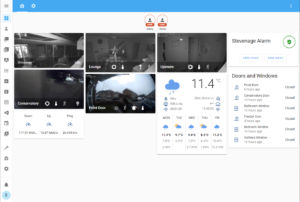
Home Assistant Introduction
Overview
I have been using Home Assistant for 6 months and it has been an amazing investment of time and energy. Home Assistant is like the controller or brains behind any home automation. As a community project, it has it’s challenges and the rewards that come with it.
Introduction

Home Assistant is a piece (more like pieces) of software which integrate and control your home smart devices. The main objective of Home Assistance is to reduce / remove reliance on vendor cloud solutions for privacy reasons. More details can be found on their site.
My main goal of using Home Assistant has been to bring all the different platforms together. For example being able to link Lifx bulbs to Philips Hue motion sensors. Another side benefit has been to decouple voice assistances from the devices themselves. This way, if I change from Google home to Amazon’s Echo or even have both, the devices can be setup once in Home Assistant and it will update Google home and Echo’s Alexa without having to them up for each platform.
Hardware
Home Assistant needs a computer to run the software and kept on all the time to monitor device states and events. This is the downside to not using cloud because that is maintained for you.
Home Assistant makes the barrier to entry very low by targeting Raspberry Pi. This is at best an entry level way of trying out and running Home Assistant but as soon as you start to rely on it and add more devices your requirements will out grow it very quickly.
Install
I won’t cover the steps to install Home Assistant because there are many articles that do that (See below for examples). One thing I wanted to point out was the methods of install Home Assistant offers.
This is all based on the time of writing from this point forward.
Home Assistant is split into two architectural components. Home Assistant core which has the bare bones Home Assistant. Then there’s Supervisor which adds a management layer on top of Core such as automated upgraded and additional plugin store.
It’s best to install Home Assistant with Supervisor also known as in Supervisor mode. You can see if you have done this when there is a Supervisor tab.
The next thing to point out are the different installation and environment methods:
- Direct
- Virtual Machine
- Containers/Docker
- Raspberry Pi
The recommended method is virtual machines where possible.
Summary
The system has changed our lives and it is now integral to our home living for the past 3-5 months. Like most home projects, it does need a tinkerer willing to dive into some of the technical guts like yaml and for better performance, separate database.
HOW TO Install HOME ASSISTANT – Container & Supervised methods (2020)
Install HASS.io on Docker – Run HASS.io on Ubuntu / Debian Systems
Lovelace storage mode is the default way to configure your overview (dashboards). You can tell if you’re using storage mode if you don’t have the following in your configuration.yaml file:
lovelace:
mode: yaml
List of resources from themes to addons:
Awesome Home Assistant
Some of the items I’ve used include:
Lovelace animated weather card
Hass.io Google Drive Backup
Lovelace: Swiper card